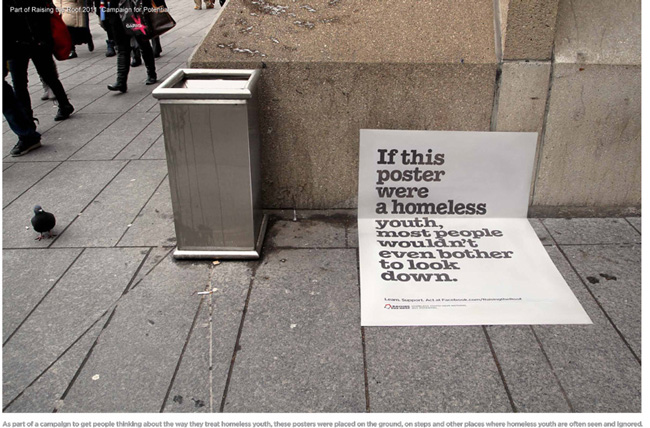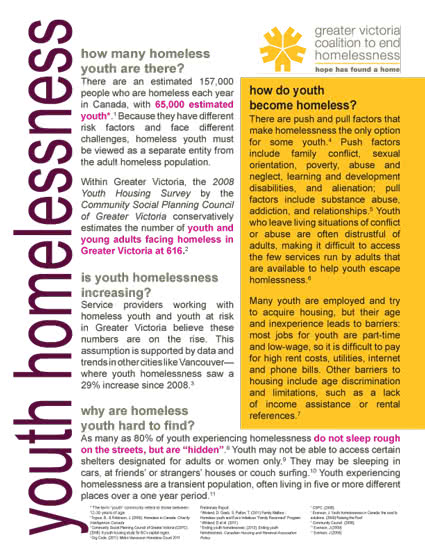
Just six more days until the bell rings for thousands of students across Greater Victoria – it’s time to head back to school. Students and parents are busy getting those last minute items; backpacks, binders, the perfect back to school outfit, juice boxes, snacks, the list goes on and on. But this isn’t the case for all youth. As youth who are homeless get ready for this school year, they have to consider where they will live and what they will eat, in addition to which classes they’ll take.
It is difficult to grow and change from child to adult. Adding the serious physical and emotional threats that go along with homelessness creates overwhelming challenges at an already challenging time. An estimated 65,000 youth experiencing homelessness face these challenges across Canada. A 2008 study asked youth service providers to estimate the number of youth and young adults at risk of homelessness in Greater Victoria. They came up with a conservative estimate of 616. Now, these service providers agree this number has increased since 2008.
Despite the increase we often don’t notice these youth, even though many sit in the classrooms with our own children. Youth experiencing homelessness are hidden: about 80% of them don’t sleep on the streets, but instead sleep in cars, at friends’ or strangers’ houses or couch surf, moving from place to place as circumstances change.
Homelessness is not a choice. Too often a youth decision to leave home is the healthiest (and only) option available to them. Some flee issues around family conflict, sexual orientation, poverty, abuse and neglect, while others may become entangled in substance abuse and addiction issues.
Once a youth is homeless, it’s hard to get out. Due to age restrictions, many youth can’t access shelters for the adult homeless population, making it hard for them to connect with services to help end their homelessness. Youth also face barriers when trying to get their own housing. Paying rent and bills is virtually impossible with a part-time minimum wage job; add to that many landlords don’t want to rent to youth. So, many youth are forced to remain hidden, or move to the streets.
Without proper housing, food and supports, the health of a youth experiencing homelessness is at risk. Homeless youth have higher rates of HIV and STI’s, and of anxiety and depression issues compared to housed youth. It’s difficult to grow into a healthy adult when you’re unhealthy, poorly nourished and stressed.
While this paints a bleak picture, we can prevent youth homelessness from happening by making sure youth know where to turn when their home isn’t safe. With the coming school year upon us, we recognize the hard work and effort of teachers and schools in mentoring and supporting youth in need. Unfortunately, with limited time, funding and resources they can’t ensure that no one falls through the cracks.
Organizations for youth in Greater Victoria, like Salvation Army’s Beacon of Hope House, the Youth Empowerment Society, Threshold Housing, and Beacon Community Services meet the immediate needs for food, shelter and supports. Still, because the numbers are growing, these supports are not enough. We call for more youth-specific supportive housing, a model that provides housing and support services, like counselling, job training and addiction treatment to get youth into homes, and out of homelessness.
On a federal and provincial level, homeless youth must be recognized as distinct from the greater adult homeless population, and specific policies for youth must work to protect and prevent youth from homelessness.
Every youth should be able to go to school, and to have a place to come home to that is safe and appropriate, after that school day ends.

Read our Youth Homelessness Fact Sheet for more information.
In the recent “Campaign for Potential” by Raising the Roof, these images were created to raise awareness of youth homelessness:
[portfolio_slideshow]
Challenges Faced by Greater Victoria Youth
- Current policy discourages housing managers housing youth in subsidized housing with marginalized adults.
- Some, but not all, youth qualify under specific criteria for some financial support from the government. To qualify, youth must not be able to return to their home or an alternative arrangement, and are expected to be attending school and working.
- When a youth qualifies for a Youth Agreement the Ministry of Children and Family Development, they can qualify for up to $900 monthly to pay for:
- $500 towards rent
- $283 towards support
- Bus pass
- Hydro bill
- Cell phone bill
- Without a history with the Ministry of Children and Family Development: can qualify for up to $610 monthly if seeking employment and unable to live with parents or guardians.
- When a youth qualifies for a Youth Agreement the Ministry of Children and Family Development, they can qualify for up to $900 monthly to pay for:
- The average rent of a Greater Victoria bachelor suite –the most affordable option- is $665 per month
- Youth under 18 can’t apply for BC Hydro services
- Youth under 19 can’t apply for internet or phone services with Shaw or Telus
- Due to inexperience, youth must often work part-time for minimum wage and no benefits

Its a shame that one of the best resources for homeless youth in Victoria The Street Out Reach Van at the YMCA lost its funding.
Since 1997, there have been only 16 dedicated beds to youth transitional housing in the Victoria Capital Region District. Current studies indicate the need is much higher and that the at-risk youth population is increasing. In the meantime, the literature shows that stable housing is the key factor to having homeless youth and at-risk youth find their way back into mainstream society in order to build a life for themselves.
The key challenges faced by at-risk youth in the region seeking safe housing have been, as mentioned above, affordability and prejudice toward their age. Most youth at risk of being homeless left difficult home situations or were aged out of care to find themselves in more desperate circumstances of being unable to find a safe sanctuary, something we are need and appreciate. Everyone likes to come home and close the door behind them and feel safe. Many youth in the region do not have this opportunity.
While most youth are resilient and want to move ahead, there are a number of barriers for someone who is unprepared to be independent. Most youth who have aged out of care or had to leave home have no prior experience of independence and therefore need a helping hand up. Looking for safe accommodations becomes complicated if the youth is suffering from depression, stress disorders, substance abuse and a history of sexual, physical or emotional abuse.
Three strategic moves that would greatly assist the regional situation would be to 1) have a policy for mental health, addiction, child welfare and juvenile correction services not to discharge any youth into homelessness; 2) have a centralized “one stop shoppe” for youth to find resources to help them meet their needs so that there is “no wrong door”; 3) have a regional plan to address and end youth homeless within 5 to 7 years.
The common myths that many youth are from outside the province or the area and that many are simply seeking adventure are not true. A McCreary Centre Society report (Against All Odds, 2007) showed that for the lower mainland and Victoria, 84% of the at-risk youth population were local. In the meantime, youth don’t leave a safe environment. Sometimes going to the street is the only option when all your supports are either threatening, dangerous or have abandoned you.